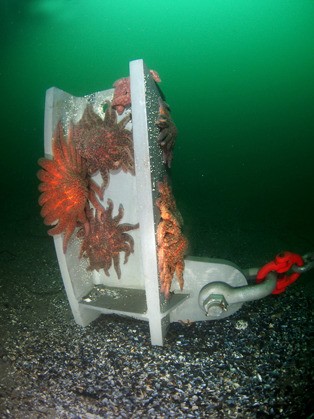While researchers have discovered the virus causing millions of sea stars to die off, Whidbey islanders remain concerned.
“It is incredible to observe the phenomenon in which so many sea stars can disappear within such a short period of time,” said Jan Kocian, a South Whidbey diver. “In one week, an animal the size of a bicycle wheel can dissolve into a small pile of goo.”
Dying starfish have been reported off the coasts of Whidbey and Camano islands over the last year and local divers and beach watchers have seen the population diminish to almost nothing.
Scientists have pin-pointed the pathogen causing the sea star wasting disease that’s been killing starfish by the millions along the Pacific shores of North America, according to findings reported last month by the Public Broadcasting System.
Identifying the virus was a challenge, according to PBS, because a drop of seawater contains about 10 million viruses.
Called “densovirus,” the illness causes a deflated appearance followed by rapid deterioration, leading to death within days, according to the University of California Santa Cruz, which has been recording the phenomena internationally.
“I am fairly hopeful they’ll be back … As long as there are survivors, they’ll be back.”
Charles Seablom,
Island County Beachwatcher
The first symptoms were reported in June 2013 in Olympic National Park.
Kocian moved to Whidbey in 1990 and has been diving for 50 years, with favorite diving spots around Deception Pass, Keystone Jetty and the Langley marina.
Kocian said that early this year in “the Langley marina you could see hundreds, if not a thousand sea stars, including the largest of them, the sunflower sea star, which is the hardest hit species.” On a dive this past summer, however, he only saw two sunflower sea stars and both were showing signs of the disease.
Island County Beachwatcher Charles Seablom said that while he hasn’t actively sought sea stars since September, a trip to Coupeville this week shows that the problem persists.
“I was in Coupeville a few days ago and stopped by the wharf where hundreds of sea stars are usually visible,” Seablom said Monday. “I saw none.”
He added that at West Beach last July he saw 33 sea stars, a number that shrank to four by September.
The sea star experiences a die-off every 10 years or so, but “never before at this magnitude or this large a geographic area,” Seablom said.
Now that the cause is known, researchers plan to develop antibiotics to help combat the virus but will also be watching to see if the new crop of baby star fish evolve and become more resistant, according to PBS.
Researchers also pointed out that 10 years prior to the outbreak, sea stars were considered overabundant and that the virus may just be nature’s way of controlling the population.
Seablom said he’s hopeful about the research and that the sea star has continually come back after previous die-offs.
“I am fairly hopeful they’ll be back,” Seablom said. “At least they found the cause anyway. As long as there are survivors, they’ll be back.”


